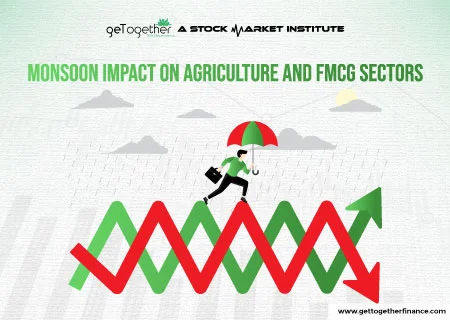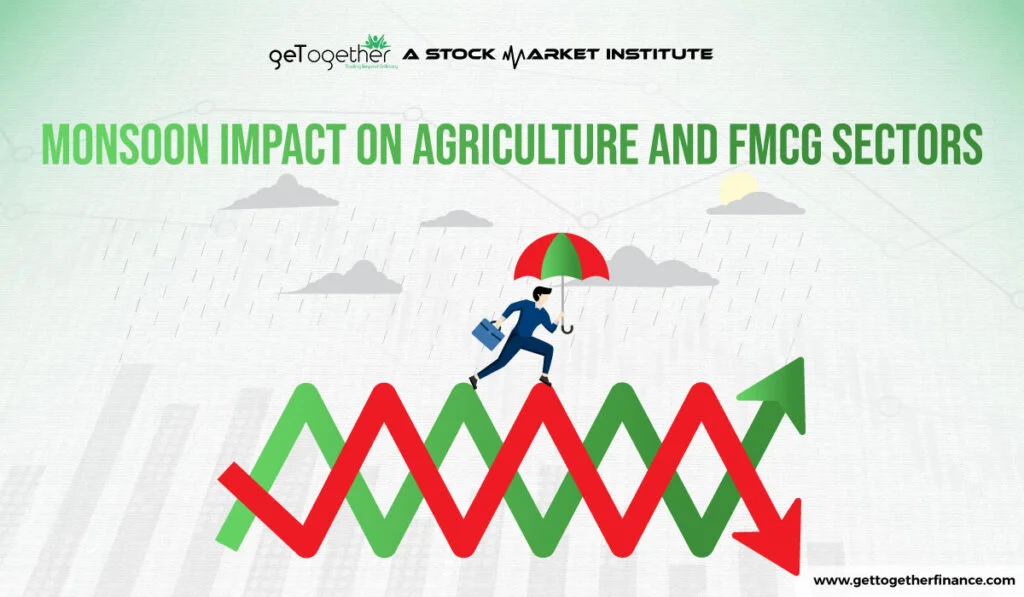Monsoon Impact on Agriculture and FMCG Sectors
- July 15, 2024
- 555 Views
- by Manaswi Agarwal


Monsoon is the season of celebration in India and first rains are perceived as a tradition in Indian society. This season in India is not only a weather change but the Indian economy; people, companies and the stock market have a great impact on this weather. Indian stock market participants actively monitor monsoon rainfall to find best opportunities in the market. Monsoon and FMCG sector in the stock market have strong linking as they are dependent on each other according to several investors.
Also Read: Healthcare Sector
Table of Contents
ToggleImpact of Monsoon on Indian Economy

The Indian economy straightforwardly gets affected by the monsoon as it impacts the performance of the agriculture sector. A well distributed rainy season enhances agricultural productivity which ultimately boosts the demand of goods and services. Government also focuses on increasing its exports by selling agricultural surplus to other countries, boosting the Indian economy. It is expected that a good performance of monsoon and FMCG sector in India can boost up the GDP by almost 3% as a result of increased agriculture production.
Conversely, the economy has to face several challenges due to deficit rainfall. A bad monsoon in India results in increasing food prices as it majorly affects agriculture production. Moreover, the government has to provide financial relief to the farmers through subsidies and loan waivers. Irregular rainfall affects the agriculture production massively which in turn has a spiral effect on the economy as the majority of the Indian economy is dependent on the agricultural sector.
Monsoon and FMCG Sector

The FMCG sector is very sensitive to monsoon and is directly impacted by the amount of rainfall. Monsoon and FMCG sector are dependent on each other for good performance of the stocks. The demand and supply dynamics of agricultural commodities are directly affected by the monsoon. A good monsoon satisfies consumer demand by maintaining the supply of food. FMCG companies that deal in agricultural products such as food and beverages are impacted directly. A good rain is an indicator of positive returns because it ensures a steady supply of raw materials at a stable price. It leads to an increase in demand for products like rice, wheat, pulses and has an influence on their prices and availability.
Key FMCG Players in the Stock Market
Some major FMCG players in the market include HUL, Dabur, Godrej Consumer, and ITC are positively affected by good monsoon. An increase in the demand for products increases the purchasing power which positively impacts the stock prices of these major players. Additionally, an increase in farm production reduces costs of raw materials which benefits the companies engaged in packaged food business such as Britannia, ITC and Nestle. To understand monsoon and FMCG sector, you can track the past performances of these stocks. During this season investors can keep an eye on some of the agriculture stocks like:
- Nath Biogen
- Sharda Corporation
- Chambal Fertilizers
- Bayer CropScience
Importance of Technical Analysis

Technical analysis helps traders to determine the relation between monsoon and FMCG sector through charts and trends of the stocks. With the help of this they are already aware about the market movements according to seasonal changes. An individual can easily analyze how monsoon and FMCG sector relates to each other through technical analysis. They can plan their strategies before anyone else while enjoying the great moves. On the top of this demand and supply theory is one approach that helps to analyze the price action at the bottom prices. Technical analysis provides the best solution to place entry and exit points through chart patterns. Let us understand how charts can help to know the impact of certain events.
Trend Analysis
Traders can analyze the trends and anticipate future moves in the prices. An up move in the trend signifies buying pressure in the asset suggesting buying opportunities for individuals. Investors or traders must follow the trend to pick the best opportunities. It can be seen that monsoon and FMCG sector tend to follow a similar trend as the prices move in same direction.
Candlestick Chart Patterns
Chart patterns determine the price action followed by a security. It represents the historical data of an asset based on which it can be analyzed if it is safe to invest in a particular security or not. The chart forms an action indicating a buying pressure if the monsoon appears to be good or the economy is moving in a positive direction. The chart patterns clearly identify the performance relation between monsoon and FMCG sector.
Demand and Supply Analysis
The inter relation between monsoon and FMCG sector implies that demand increases during a good monsoon affecting the stock prices. The chart itself represents if the stock is in the demand zone representing potential buyers in the market. When the price enters a demand zone it signals traders that a buying pressure in the security is about to come. On the other hand, if the price enters the supply zone, investors are informed about significant selling in the security. Therefore analyzing demand and supply zones can majorly impact your decisions.
With the help of this investors can determine better entry points at the bottom areas and exit points at the top. This can all be done with better risk management activities and sector support. Investors need to implement the theory with due diligence by setting the stop losses as well as planning entries carefully.
Conclusion
The majority of the Indian economy is based on the agriculture sector which is directly impacted by the amount of rainfall in the country. Monsoon and FMCG sector tend to perform in the same direction which affects the stock prices. Apart from this technical analysis is a strong analysis method which allows the traders to understand the price action by determining the chart patterns. The GTF-Trading In the Zone course helps you to analyze the chart patterns through demand and supply where investors can get to know the price action beforehand.
FAQs
Does monsoon affect the Stock Market?
Monsoon and FMCG sector or agriculture companies have significant impact on each other because the Indian economy consists of a major portion of the agriculture sector. So it does have an impact on the stock market which can be analyzed through charts and technical analysis.
Which stocks are majorly affected by the monsoon?
Assets belonging to the FMCG sector such as HUL, Dabur, Nestle, and ITC are the major companies whose stocks can get affected by the monsoon. A good monsoon can boost up the share prices and vice versa.
Do stocks go down in the summer?
It is not necessary that in summers, stocks will experience a significant fall. Any fall in the stocks can be determined through the analysis of technical charts.
How to predict the price action of stocks?
To analyze the price action of stocks, demand and supply is one main concept through which a complete candlesticks chart pattern is analyzed and actions are taken based upon that. You can learn about the price action of a stock from GTF Trading in the zone course.



 Instagram
Instagram
